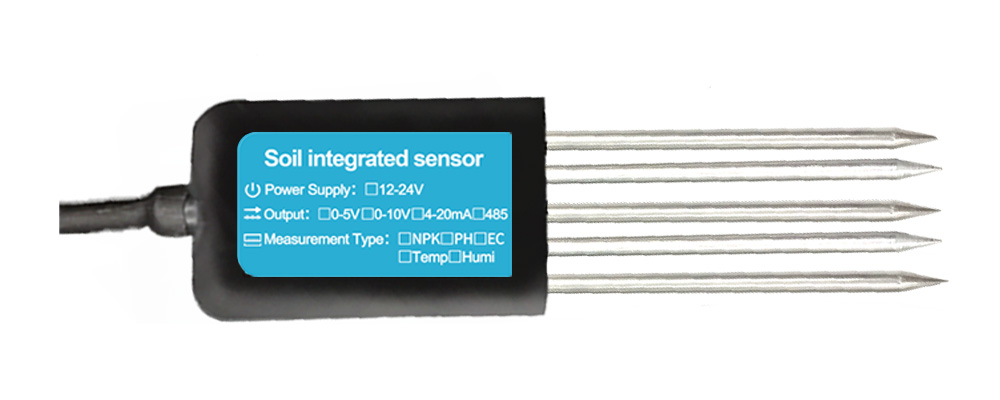Soil sensors are essential tools for monitoring soil conditions and optimizing plant growth. They provide information on soil moisture, temperature, nutrient levels, and other parameters that impact plant health and productivity. Soil sensors find applications in agriculture, horticulture, landscaping, and environmental monitoring. In this article, we will explore the main types of soil sensors and their functions.

Soil Moisture Sensors Soil moisture sensors measure the water content in the soil, providing critical information on plant water requirements and irrigation management. There are several types of soil moisture sensors, including tensiometers, gypsum blocks, time-domain reflectometry (TDR) sensors, capacitance sensors, and resistance-based sensors.
Tensiometers measure soil moisture tension or the suction force exerted by the soil on water. Gypsum blocks measure soil moisture content by monitoring the electrical resistance of a porous ceramic block. TDR sensors send electromagnetic pulses through the soil to measure the dielectric constant of the soil, which correlates with soil moisture content. Capacitance sensors measure soil moisture content based on the dielectric constant between two electrodes inserted in the soil. Resistance-based sensors measure soil moisture content by detecting changes in electrical resistance between two probes inserted in the soil.
Soil Temperature Sensors Soil temperature sensors monitor soil temperature, which is an important factor in plant growth and development. Soil temperature affects seed germination, root growth, and nutrient uptake. There are several types of soil temperature sensors, including thermocouples, thermistors, and resistance-based sensors.
Thermocouples measure temperature by detecting changes in voltage generated by two dissimilar metals in contact. Thermistors measure temperature based on the change in resistance of a semiconductor material as temperature changes. Resistance-based sensors measure temperature based on the change in electrical resistance of a metal wire as temperature changes.
Soil Nutrient Sensors Soil nutrient sensors measure the concentration of nutrients such as nitrogen, phosphorus, and potassium in the soil. These sensors help farmers and growers optimize fertilization practices, reduce fertilizer application rates, and prevent over-fertilization, which can lead to environmental pollution.
There are several types of soil nutrient sensors, including ion-selective electrodes (ISEs), optical sensors, and electrochemical sensors. ISEs measure the concentration of specific ions such as nitrate or ammonium by detecting changes in voltage generated by an ion-specific membrane. Optical sensors detect changes in light absorption or fluorescence of a solution containing the target ion. Electrochemical sensors measure the current generated by the reaction between the target ion and an electrode.
Soil pH Sensors Soil pH sensors measure the acidity or alkalinity of the soil, which is a critical factor in plant growth and nutrient uptake. Soil pH affects the availability of nutrients and the solubility of toxic elements. There are several types of soil pH sensors, including glass electrodes, field-effect transistors (FETs), and colorimetric sensors.
Glass electrodes measure pH based on the electrical potential generated between a reference electrode and a pH-sensitive glass membrane. FETs measure pH by detecting changes in the gate voltage of an ion-sensitive transistor. Colorimetric sensors measure pH by detecting changes in the color of an indicator solution.
Soil Gas Sensors Soil gas sensors monitor the concentration of gases such as carbon dioxide, oxygen, and methane in the soil. These sensors provide information on soil respiration, microbial activity, and pollutant emissions from the soil. There are several types of soil gas sensors, including infrared sensors, electrochemical sensors, and metal oxide sensors.
Infrared sensors measure the absorption of infrared radiation by gases in the soil, providing information on their concentration. Electrochemical sensors measure the current generated by the reaction between a gas and an electrode. Metal oxide sensors detect changes in resistance as gases interact with the sensor material.

Conclusion Soil sensors play a critical role in agriculture, horticulture, landscaping, and environmental monitoring. Soil moisture sensors, soil temperature sensors, soil nutrient sensors, soil pH sensors, and soil gas sensors provide valuable information on soil conditions, facilitating precise irrigation, fertilization, and plant management practices. By utilizing these sensors, growers can optimize crop yields and quality, reduce resource consumption, and improve sustainability. The continuous development of sensor technologies enhances their accuracy, sensitivity, and reliability, enabling smarter decision-making in soil management.
